Crane Operation Training
NOTE: All Training and Testing Material is for LSU CAMD Users ONLY!
Crane Training - Information Reduces Risk
Crane training is required for all individuals who wish to use the crane at CAMD.
This manual is presented as a guide and may be used for retraining/re-certification
only. Initial training in crane safety requires an appointment made through CAMD safety
and a minimum of a two hour time commitment to learn about general crane safety rigging
and lifting procedures. You may contact CAMD safety by dialing 8-4616 from any CAMD
facility phone or from the LSU campus. Those wishing to reach CAMD safety from other
locations should dial 225-578-4616. This document contains information of use for
all individuals using the crane at the CAMD facility.
The CAMD crane was manufactured by Gaffey Crane Company of Houston, Texas. It is equipped
with a two ton limit crane hook. Gaffey performs yearly maintenance and emergency
repairs. A spreader bar is also available, which has the advantage of distributing
the weight of the load on two hooks.
Rigging materials are available in the electrical room of the utility building of
CAMD. Always inspect all rigging before use. Be aware that it is easy to damage nylon
rigging on sharp or protruding corners.
Safety Instructions
- Do not lift people and never ride the hoisting load.
- Do not lift load over people. No one shall be under the hoisting load.
- Make sure the sling is well balanced. Avoid tip loading, and loading on hook latch.
- Never lift the load over the rated capacity.
- Do not operate with kinked, twisted or damaged chain.
- Avoid side pull or end pull, and quick reversal operations.
- Never leave the suspended load unattended.
- Make sure you take up slack slowly.
In addition to improper rigging, cranes hitting overhead obstacles represent the most
frequent hazards of crane operation. Before beginning a lift, clearly inspect the
entire proposed path of the crane, paying particular attention to overhead obstacles
(especially overhead electrical hazards which could be fatal) and whether the path
of the crane will pass directly overhead of any individuals. Always have a spotter
available, particularly in blind spots. Never exceed the crane capacity and never
attempt a critical lift unless you have years of experience in utilizing the CAMD
crane. A critical lift is defined as one exceeding 90% of the rated capacity of the
crane. For the CAMD crane, a critical lift is greater than 3600 pounds.
A crane is a vertical lifting device. It should never be used to drag or pull a load.
Always position the crane directly perpendicular to the load to be lifted. Non-vertical
lifts can damage both the crane and the rigging materials and may result in improper
wrapping around the drum. If the drum wraps are not seated in the proper position,
immediately cease crane operation and inform facility maintenance.
An operator who leaves a load suspended and unattended is subject to disciplinary
action, which may include revocation of his or her license to operate the crane.
Checking Limit Switch
- Move crane to open area.
- No load should be on hoist lines.
- Slowly run (#2 position) block up to 3’ from limit switch and stop.
- Continue to raise hook slowly (#1 position).
- If limit switch does not operate at point where it should, don’t use crane.
The first procedure in any crane lift is to assess the valid performance of the limit switches of the crane. To accomplish this task, run the length of the crane rope to the lower limit. For CAMD, this limit is approximately 4 inches from the floor. Make sure that at least 2.5 wraps remain on the drum. Once the lower limit switch has been tested, raise the crane hook to the upper limit switch, all the while making sure the rope wraps correctly. There should be no cross wrapping or ill sitting of the rope on the grooves of the drum. Ensure the top limit switch stops before hitting the drum. As you approach the top limit switch slow the crane from the fastest position (3) to the slowest position (1) to prevent hitting the upper limit. If either limit fails the crane should be locked out. The electrical control panel for the operation of the crane is to the left of the experimental hall door (on the receiving side) adjacent to the log-out tags. Pull the lever down to place in the off position.
Inspection and Maintenance
- Inspection and lubrication are done twice yearly.
- Daily before operating:
- Check battery
- Check all controls
- Visually inspect
- Wire rope for kinks or damage
- Sheaves, drums for damage
- Upper and lower limit switches.
CAMD maintains a rigorous inspection program. All maintenance is performed only by
qualified personnel. Being a qualified CAMD crane operator does not qualify one as
maintenance personnel. Maintenance is required whenever a wire has wrapped incorrectly
on the drum or a limit switch fails in either the upper or lower modes. In case of
any suspected failure the operator must immediately cease operation, remove power
from the crane and inform the facility management or CAMD safety. Place a lockout
tag on the remote control unit. All CAMD crane operations are conducted using the
portable remote control for the crane. After retrieving the remote control, check
the level of the battery. If the battery does not register in the green, replace the
battery before continuing. Collect suitable slings for properly securing all loads.
Examine slings for any defects. Before beginning any lift, check upper and lower limit
switches without any weight attached. The crane limit is 2 tons (4000 pounds) which
must include the weight of all rigging equipment. A scale is available to check overall
weight.
Once the crane has been established to be working properly, rig the load properly,
attaching tag lines for loads which might be susceptible to swing. Always ascertain
that the area over which the load will travel, is free and clear of personnel or other
potential obstacles.
Rigging
- Loads should be well secured.
- Slings should be adequate to the task.
- Slings should be unkinked and load balanced and secured.
- No sudden stops.
- No obstructions while lifting or traveling.
- No loose items on load or crane before lift.
- Bumping into runway stops is prohibited.
- Hoist line must be vertical prior to the lift (remove slack in the hoist slowly).
- No crane load should pass overhead of personnel, clear the area before making the lift.
- No one is to ride the crane without permission.
The most important job of any crane operation is rigging of the load. Poor rigging
may result in personnel injury, property damage, or other serious hazards. Rigging
is the most time consuming of any crane operation and represents the single most hazardous
potential of crane operation. In a multi-sling operation, each leg must be of the
same length and must contribute equally to load distribution. Nylon slings are susceptible
to damage by sharp corners on the item to be rigged. Caution must be taken to ensure
that slings are not damaged by sharp corners or by excessive loading. Rigging requires
years of practice to perfect. If in doubt about the security of your rigging, ask
for help.
Rigging should be checked by lifting the load a few inches off the ground to ensure
that no swing develops and that the load is completely secure. Remember it is important
to take the time to accomplish this task correctly. Not doing so may result in catastrophic
consequences. One of the most important things to check before lifting a load is to
look for loose items, such as screws or tools which may have been used to secure the
load. Such items can become projectiles during a lift. This is the reason why crane
operators or especially tag line operators should wear hard hats when operating the
crane and why it is essential to make sure the path of the crane does not pass over
the head of any individual.
Center of Gravity

It is always important in rigging practice to rig the load so that it is stable. A
stable load is one in which the center of gravity of the load is directly below the
main hook and below the lowest point of attachment of the slings.The center of gravity
of an object is that point at which the object will balance. The entire weight may
be considered as concentrated at this point. A suspended object will always move so
that the center of gravity is below the point of support. In order to make a level
or stable lift, the crane or hook block must be directly above this point. Thus a
load which is slung above and through the center of gravity will be stable and will
not tend to topple or slide out of the slings.
Predicting the center of mass for an object to be lifted is not a trivial matter.
It may require several attempts at rigging to find the appropriate balance point.
Many objects are not rectangular such that predicting the center of mass is often
difficult. In all crane lifts the center of mass must remain below the hook and below
the point of attachment for any rigging. A center of mass above the hook is inherently
unstable and will cause the load to flip. Similarly, loads which are not balanced
in the horizontal plane may slip from the rigging. The overall stability of the load
is a combination of balance with respect to center of mass, weight distribution, and
rigging tightness.
Weight Vs Angle
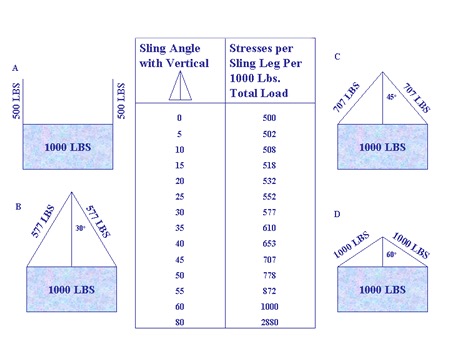
The angle at which a sling holds a given load influences the effective weight of the load. Stresses are minimal for loads with slings held perpendicular to the load, as shown in Figure A. For distributing the load vertically among more than a single leg of a sling, a spreader bar may be used. As shown in figures B-D, increasing the angle of the sling to the hook from 30 to 60 degrees increases the effective mass of the load from 1154 lbs to 2000 lbs, essentially doubling the weight on each leg of the sling at 60 degrees. The chart in the middle offers a handy guide for assessing the effective angle of the sling to the relative weight. Thus, it is always better to limit the angle of the sling. Further, such changes in sling angle must be accounted for in lifts that are close to the sling weight limit and/or for critical lifts (greater than 90% of the crane limit). Crane operators should download a copy of this chart and carry it with them during crane operations.
Sling Position


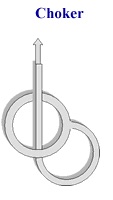
Crane lifts require the use of slings. Slings are generally made of nylon or wire
mesh. Nylon slings have the advantage of being easy to wrap around a load but can
be easily cut or damaged if used improperly. Nylon slings which have been mishandled
are subject to bleed-through. A red ink mark appears on the surface at the point of
damage. Inspect all slings before use. Wire slings should have no more than two wires
out of nine broken. Discard all damaged slings immediately.
Rigging slings may be utilized in three basic manners. Each sling carries with it
a label with rated weight limit capacities for vertical, choker, or basket configurations.
The basket configuration, which is analogous to using a spreader bar to distribute
the weight on two legs instead of a single vertical sling, represents the highest
rated capacity. This basket configuration is roughly twice as strong as the vertical
configuration. A typical example would be a basket configuration with a 7200 lbs capacity
would have a vertical capacity limit of only 3600 lbs. Taking a single sling and using
it in the choker configuration would further degrade the capacity of the sling, dropping
the rate of capacity of 3600 lbs in the vertical position to 2900 lbs in the choker
position. Thus, in addition to the sling angle, sling position must be considered
for all crane lifts.
Signals

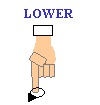
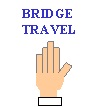

- HOIST: With forearm vertical, forefinger pointing up, move hand in small horizontal circles.
- LOWER: With arm extended downward, forefinger pointing down, move hand in small horizontal circles.
- BRIDGE TRAVEL: Arm extended forward, hand open and slightly raised, make pushing motions in direction of travel.
- TROLLEY TRAVEL: Palm up, fingers closed, thumb pointing in direction of motion, jerk hand horizontally.


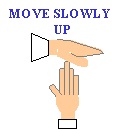
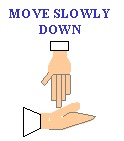
- STOP: Arm extended, palm down, hold position rigidly.
- EMERGENCY STOP: Arm extended, palm down, move hand rapidly right and left. An emergency stop signal must be accepted from any person.
- MOVE SLOWLY: Use one hand to give any motion signal and place other hand motionless in front of hand engaging in motion signal.
The emergency stop signal is a horizontal hand wave of the extended arm. It is important
to immediately react because the person giving the signal may have knowledge that
the crane operator does not, including: better view, knowledge of hazards, etc.
Obey all STOP signals regardless of who gives them. Other than EMERGENCY STOP, signals
should be accepted from only one person at a time (normally the spotter for the operator).
Use standard crane signals and do not move unless directions are clear.
Know standard hand signals (shown above). Hand signals are important because background
noise may make communication difficult.
Safe Lifts
In order to make a safe lift the following information must be known
- Weight of item to be lifted (total).
- Center of gravity of the load.
- How to rig the load.
- How to control the load at all times.
The capacity of the CAMD crane is 4000 pounds. The weight limitation occurs because of the small hook attached to the lifting mechanism. Stabilization of the loads may be made possible by the use of a spreader bar, which gives 2 points of attachment, instead of the usual one point. The weight of the spreader bar must be included in the total weight of the lift. A crane scale is available to ascertain the total weight of the lift . Once the weight has been determined to be within the crane capacity, it is necessary to determine the center of mass. Loads not accurately balanced will tip or swing and result in a hazardous lifting environment. Light loads are apt to swing more readily and may require attachment of one or more tag lines to impair rotation of the load. This requires 1 or more individuals in addition to the crane operator.
Operator Do's and Don'ts
- Do not eat or drink.
- Do not sleep.
- Never divert attention when there is a load.
- Practical jokes are forbidden.
- Do not use alcohol or other intoxicants.
- Do not operate if taking medication.
Crane operation is a serious responsibility which should never be taken lightly. A properly trained crane operator will never approach another crane operator during a lift unless he/she observes a hazardous situation which requires immediate cessation of the lift. People with poor peripheral vision or diminished capacity due to ingestion of pain relievers, decongestant or other medication which may impair their mental acuity should not operate any crane. The use of alcohol or other intoxicants by crane operator is strictly forbidden and will result in loss of crane operator privileges.
Crane Safety After Use
- Spot crane in the approved location.
- Lower the load to the ground.
- Disconnect the load and slings.
- Raise all the hooks to upper limit switch.
- Place all controls to off position.
- Visually check for dangerous conditions.
- Never leave a load unattended.
After completion of a safe lift, spot the crane in an approved location. The CAMD crane should never be left directly over the 90 degrees bending magnet of the storage ring because the bulk of the crane can act as a strong scattering force and contribute to sky shine radiation. Never leave a load attached to the crane and if you must absent yourself from the locale of the load, always take the controller with you. Always lower the load completely to the ground and give yourself some slack in the slings before attempting to remove the rigging from the crane hooks. Remember only vertical lifts must be made and dragging of the load horizontally is specifically forbidden. Ensure that the operator can see all potential hazards clearly at all times; otherwise, a crane spotter is necessary for all lifts. Once crane rigging is removed, return crane hook to upper limit switch. This will prevent the potential for the crane hook to hit any potential obstacles when the crane is next moved along its circular path.
Crane and Rigging Safety Rules
- Check limit switches before rigging the load.
- Make sure the load does not exceed rated capacity.
- Know the center of gravity of the load.
- Attach load above the center of gravity for stability.
- Select hitch that will control the load.
- Know the rated capacities of rigging and slinging.
- Inspect all rigging before use.
- Protect the sling from sharp corners.
- Allow for increased tension due to sling angle.
- Equalize loading on multiple leg slings.
- Allow for load reductions when using choker hitches.
- Attach tag line prior to lift.
- Keep personnel clear of lift area.
- Wear hard hats when making overhead lifts.
- Lift load a few inches and verify rigging.
- Check for any loose items.
- Know limitations of hoisting device.
- Start and stop SLOWLY! Watch for obstructions (not only hook and load but outboard end of the bridge).
- Check pathway is clear before making a lift (use a spotter for blind spots).
- Verify hook completely closes.
- Use appropriate hand signals.
- Maintain load control at all times.
- Report suspected drum wrappings immediately (if drum has fewer 2.5 wraps remaining).
- Never leave load unattended.
Crane Personnel
- Person must be able to read and speak the English language fluently.
- Person must be 18 years of age and familiar with normal operating practices and procedures.
- Person must have good hearing and vision (with or without correction) and must have good depth perception.
- Person must not be afflicted with any known heart or other health conditions that might cause sudden loss of ability to react.
- Person must have been adequately instructed for crane operation.
- Operator must be qualified to rig the load safely. Qualification is a demonstrated ability to rig a load as a part of crane training. The operator must have recieved training which includes theory, practice and testing.
- Before operating a crane with which the operator is not familiar, the operator must read the instructions provided by the manufacturer and note any special instructions, paying particular attention to the function and operation of each control.
Each crane operator should be held directly responsible for the safe operation of the crane or hoist. Whenever there is any doubt as to safety, the operator should stop the crane and refuse to handle loads until safe conditions have been restored. There is a minimum requirement of 18 years of age and fluency in the English language to operate the CAMD crane. Persons must also have good hearing and peripheral vision. These attributes are necessary for safe operation of the crane. All crane operators must have have received training including: written materials; hands on experience; and testing of knowledge, both written and practical. Persons must also have had some training in the important fundamentals of rigging loads. Crane operators using a new lifting device must be familiar with the manufacturer's directions, noting any special instructions. No lifts over 100% rated capacity may be made without the prior written consent of the CAMD safety operator.